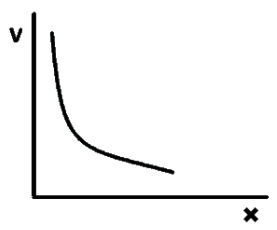
What is a potential gradient?
Answer
433.7k+ views
Hint: Gradient is defined as the rate of change of any quantity along with displacement. The gradient can also be defined as the slope of the potential to distance graph.
Complete step-by-step solution -
The potential gradient represents the rate of change of potential along with displacement. In other words, it represents the slope along which potential is changing.
It is also called dielectric stress or voltage stress.

From the graph, we can conclude that the potential gradient is high at points near the source of the voltage, and is low at the points farther from the source.
Now, this slope gives a field strength. And this is the electric field strength.
So we can write,
The terms in the expression are the electric field and the electric potential.
Electric field - The electric field is the field of force an electrically charged particle (Q1) would create, and enact force on an imaginary positively charged particle (Q2) if placed in the vicinity of the charged particle Q1.
Potential - The potential between 2 points can be defined as the difference between the electric potential energies between the 2 points. Potential tells the measure of the work required to move a charged particle in the electric field.
Use of potential gradient:
1. While making cables, the value of dielectric insulation provided is kept higher than the potential gradient of the conductor, else the cable is not safe.
2. If the value of potential gradient is kept high in Power systems then it may affect the person by touch potential.
Note: The negative sign denotes that potential increases in the opposite direction of the electric field vector. A physical example of this situation is the equipotential surfaces.
Complete step-by-step solution -
The potential gradient represents the rate of change of potential along with displacement. In other words, it represents the slope along which potential is changing.
It is also called dielectric stress or voltage stress.

From the graph, we can conclude that the potential gradient is high at points near the source of the voltage, and is low at the points farther from the source.
Now, this slope gives a field strength. And this is the electric field strength.
So we can write,
The terms in the expression are the electric field and the electric potential.
Electric field - The electric field is the field of force an electrically charged particle (Q1) would create, and enact force on an imaginary positively charged particle (Q2) if placed in the vicinity of the charged particle Q1.
Potential - The potential between 2 points can be defined as the difference between the electric potential energies between the 2 points. Potential tells the measure of the work required to move a charged particle in the electric field.
Use of potential gradient:
1. While making cables, the value of dielectric insulation provided is kept higher than the potential gradient of the conductor, else the cable is not safe.
2. If the value of potential gradient is kept high in Power systems then it may affect the person by touch potential.
Note: The negative sign denotes that potential increases in the opposite direction of the electric field vector. A physical example of this situation is the equipotential surfaces.
Recently Updated Pages
Master Class 11 Accountancy: Engaging Questions & Answers for Success

Master Class 11 English: Engaging Questions & Answers for Success

Master Class 11 Computer Science: Engaging Questions & Answers for Success

Master Class 11 Maths: Engaging Questions & Answers for Success

Master Class 11 Social Science: Engaging Questions & Answers for Success

Master Class 11 Physics: Engaging Questions & Answers for Success

Trending doubts
Give 10 examples of unisexual and bisexual flowers

Draw a labelled sketch of the human eye class 12 physics CBSE

Differentiate between homogeneous and heterogeneous class 12 chemistry CBSE

Differentiate between insitu conservation and exsitu class 12 biology CBSE

What are the major means of transport Explain each class 12 social science CBSE

What is the difference between resemblance and sem class 12 social science CBSE




